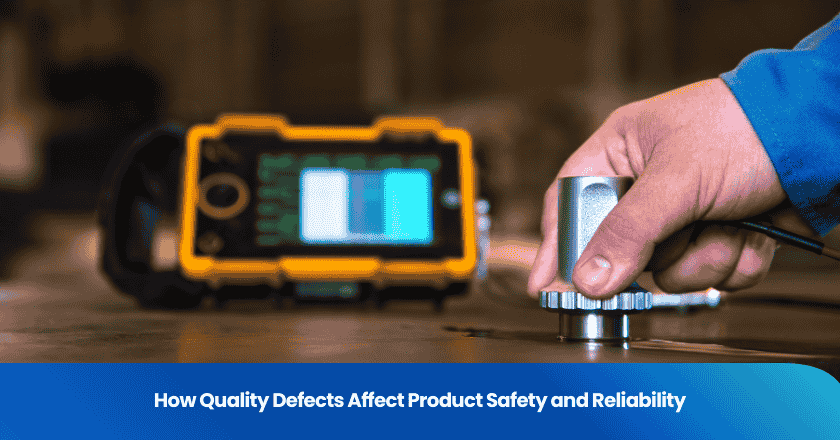
Quality defects can put your safety at risk and undermine product safety in critical ways. You may encounter different types of defects—critical, major, and minor—each with unique consequences. Recognizing these differences helps you understand why even small issues matter. Consider the following impacts on safety and reliability:
| Impact on Product Safety and Reliability | Description |
|---|---|
| Enhanced Consistency | Ensures each product batch meets quality criteria, leading to reliable performance. |
| Predictive Insights | Allows forecasting of potential quality issues before they manifest in the final product. |
| Cost Reduction | Early detection of deviations reduces expenses related to rework, recalls, and warranty claims. |
When you see quality defects examples in everyday products, you realize how they can affect not just individuals but entire industries.
Key Takeaways
- Quality defects can compromise safety and reliability. Recognizing the types of defects helps you understand their potential risks.
- Implementing effective quality control methods, like Statistical Quality Control and Total Quality Management, can prevent defects before they reach customers.
- Early detection technologies, such as machine learning and real-time monitoring, help identify defects quickly, reducing costs and protecting your reputation.
- Addressing quality defects through structured corrective actions fosters a culture of accountability and continuous improvement in your organization.
Quality Defects Overview
What Are Quality Defects
You encounter quality defects when a product fails to meet established standards or specifications. These defects can appear at any stage of the product lifecycle, from design to packaging. Quality defects often result from errors in production, assembly, or quality control processes. You might notice them as visible flaws, functional failures, or safety hazards. When you understand what quality defects are, you can better identify risks and take steps to prevent them.
Quality defects do not only affect appearance. They can compromise safety, reliability, and usability. For example, a kitchen appliance with faulty wiring may cause a fire. A toy with small detachable parts may present a choking hazard. Even minor defects, such as slight color variations, can impact customer satisfaction and brand reputation.
Types of Quality Defects
You will find several types of quality defects in manufacturing and consumer products. Each type affects the product in different ways. The most common types include:
| Type of Defect | Description |
|---|---|
| Dimensional Defects | Errors in production processes such as cutting, casting, machining, or molding. |
| Surface Defects | Imperfections on the outer layer affecting appearance, functionality, or durability. |
| Safety Defects | Flaws that pose risks of harm or injury to users or the environment. |
| Packaging Defects | Flaws in packaging that compromise functionality or appearance, affecting safety and usability. |
You also need to recognize how international standards classify quality defects by severity:
| Defect Type | Definition | Example |
|---|---|---|
| Critical | A defect that could cause injury or death. | Overheating battery in a phone, furniture that topples easily. |
| Major | A defect that makes the product unsaleable or likely to be returned. | Monitor with a scratch on the front screen. |
| Minor | A defect that deviates slightly from specifications but is still saleable. | Monitor with a scratch on the back, or a stapler with slight color variance. |
Tip: You should always assess the type and severity of quality defects to determine the appropriate corrective action.
Quality defects may also arise from design flaws, assembly errors, or environmental factors during production. By understanding these categories, you can implement targeted quality control measures and reduce the risk of defects reaching the end user.
Impact on Safety and Reliability
Safety Risks
You face significant safety concerns when quality defects go undetected. These defects can introduce hidden dangers into everyday products, putting you and others at risk. For example, a small flaw in an electrical appliance may lead to electric shocks or even fires. In vehicles, undetected defects can cause accidents, resulting in injuries or worse. The consequences of ignoring safety concerns extend beyond physical harm. You may also experience financial losses and emotional distress if a product fails unexpectedly.
Here are some documented safety risks associated with quality defects in consumer products:
1. Physical harm and injuries can occur when latent defects cause product failures, such as electrical shocks or vehicle crashes.
2. Financial losses may arise when you need to repair or replace defective products, sometimes costing more than the original purchase.
3. Emotional distress often follows product failures, leading to anxiety or trauma.
Manufacturing environments also face safety concerns due to quality defects. Equipment failures can create hazardous conditions that violate safety regulations. Regular maintenance helps prevent these issues, but lapses can result in regulatory penalties. Preventing workplace injuries not only protects you but also saves businesses from costly fines.
Note: Addressing quality defects early reduces the risk of harm and ensures compliance with safety standards.
Reliability Issues
Quality defects do not only threaten safety; they also undermine the reliability of products. When you encounter a product that fails prematurely, you lose trust in its performance. Reliability issues can lead to severe failures, especially in industries where consistent operation is critical. For example, a defect in an aerospace component can compromise safety and functionality, putting lives at risk.
You may notice several impacts when reliability suffers due to quality defects:
- Product malfunctions can cause severe failures, disrupting your daily activities.
- Costly recalls often follow widespread defects, leading to financial penalties and damaging the reputation of manufacturers.
- Assembly errors may introduce safety risks, resulting in legal liabilities.
- Premature product failures force you to seek replacements or repairs, increasing your expenses.
- Compromised performance can jeopardize safety and functionality, especially in critical applications.
- Increased liability risks expose companies to legal repercussions and reputational damage.
Reliability issues also affect customer satisfaction and brand reputation. Defects in products or services can lead to dissatisfaction, causing you to lose trust and loyalty. Frustration grows when you experience repeated failures, and you may question the reliability of the company. Over time, reputational damage can decrease market demand and affect long-term business success.
Tip: Implementing robust quality assurance processes improves reliability, reduces breakdowns, and enhances customer satisfaction.
You play a vital role in identifying and reporting quality defects. By staying vigilant, you help reduce risk and promote safer, more reliable products for everyone.
Manufacturing Quality Defects
Manufacturing Defects
You encounter manufacturing defects when problems arise during the production process. These issues often result from mistakes on the assembly line, contamination, or improper handling. Unlike design or material defects, manufacturing defects do not originate from the blueprint or the raw materials themselves. Instead, they occur after the design phase and after materials have been selected. Understanding this distinction helps you identify the root cause of defective products and take corrective action.
Here is a table that clarifies the differences:
| Type of Defect | Description |
|---|---|
| Manufacturing Defect | Issues arising during production, such as assembly errors or material impurities. |
| Design Defect | Flaws in the design phase that do not account for operational stresses or material behaviors. |
| Material Defect | Inherent flaws within the materials used that affect performance and reliability. |
In industries like automotive and electronics, manufacturing defects often appear as ignition switch failures or assembly mistakes. These problems can lead to recalls and safety concerns. You must recognize that manufacturing quality defects can have serious consequences for both users and manufacturers.
Causes in Manufacturing
You face several common causes of manufacturing defects in modern production environments. Operator error stands out as a leading factor. Workers may misalign parts, skip steps, or fail to follow procedures, resulting in manufacturing quality defects. Machine malfunction also contributes to these issues. Equipment with incorrect settings or worn-out tools can produce parts with inaccurate dimensions or poor assembly.
Supplier issues represent another major source of manufacturing defects. When suppliers deliver substandard or contaminated materials, you risk introducing flaws into the final product. These problems increase costs and reduce reliability.
- Operator error: Human mistakes during the manufacturing process, such as misaligned parts or incomplete welds.
- Machine malfunction: Equipment issues, including incorrect settings or worn-out tools, leading to inaccurate dimensions and poor assembly.
- Supplier issues: Defective raw materials from suppliers, compromising product quality and increasing production costs.
You can reduce manufacturing quality defects by adopting process controls and automation. Error-proofing systems help prevent mistakes before they reach the customer. Automation of error-prone tasks ensures precision and consistency. Automated inspection systems can reduce inspection time by up to 90% while improving defect detection rates by 50%. These strategies help you maintain high standards and minimize the risk of manufacturing defects reaching the market.
Quality Defects Examples
Critical Defects
You encounter critical defects when a product poses a direct threat to health or safety. These quality defects examples often lead to recalls or regulatory action. In healthcare, you may see unexpectedly high active pharmaceutical levels, which can cause toxic reactions or even death. Contamination with harmful substances in food or medicine can result in severe health issues, such as infections or organ damage. Defective vaccines may allow preventable diseases to spread in communities. Subtherapeutic levels of active ingredients in medicines can contribute to antimicrobial resistance, making treatments less effective. In some regions, poor quality medicines have led to thousands of deaths from treatable diseases. Medical device recalls also highlight critical defects, as faulty equipment can cause incorrect diagnoses or improper treatments, putting patients at risk.
- Unexpectedly high pharmaceutical levels
- Contamination with harmful substances
- Defective vaccines
- Subtherapeutic active ingredient levels
- Medical device recalls
Note: Regulatory agencies require manufacturers to report critical defects to maintain safety standards.
Major and Minor Defects
You also find major and minor quality defects examples in everyday products. Major defects compromise usability or safety, often leading to product rejection during inspections. Minor defects are small imperfections that do not affect function but may lower perceived quality.
| Type of Defect | Description |
|---|---|
| Major Defects | Serious issues that compromise usability, functionality, or safety, often leading to rejection during inspections. |
| Minor Defects | Small imperfections that do not affect functionality but may impact perceived quality or aesthetic appeal. |
You should always assess the impact of these defects to determine the right corrective action.
Industry Examples
You see quality defects examples across many industries. In manufacturing, safety mechanisms like fail-safes protect users from harm. Routine inspections and standardized testing help prevent errors that could lead to liability claims. In food production, clear warnings and instructions reduce risks from misuse. These practices show how industries address quality defects examples to protect consumers and maintain reliability.
Tip: Consistent quality control and clear communication help you avoid the consequences of critical defects and major defects.
Preventing and Addressing Defects
Quality Control Methods
You play a crucial role in maintaining product integrity by choosing the right quality control process. Effective quality management relies on proven methods that help you prevent defects before they reach customers. The following table highlights some of the most effective approaches:
| Quality Control Method | Description | Benefits |
|---|---|---|
| Statistical Quality Control (SQC) | Uses statistical methods to monitor and control processes. | Early detection and prevention of defects, leading to improved overall quality. |
| Total Quality Management (TQM) | A philosophy that incorporates quality into company culture and training. | Empowers employees to take ownership of quality control, improving long-term success. |
| Six Sigma | A data-driven methodology aimed at reducing defects and variations. | Focuses on process improvement and aims for a maximum of 3.4 defects per million units. |
You can integrate statistical process control with Lean and Six Sigma to enhance your quality management system. This combination allows you to reduce variability, increase productivity, and lower costs. You also improve customer satisfaction by delivering consistent results. The quality control process becomes more proactive, identifying issues before they escalate.
Early Detection
You benefit from early detection technologies that identify quality defects before they impact customers. Machine learning techniques, real-time monitoring, and advanced sensors all support your quality defect tracking efforts. The table below outlines key technologies:
| Technology Type | Description |
|---|---|
| Machine Learning Techniques | Utilizes algorithms to analyze data and identify defects based on learned patterns. |
| Real-Time Monitoring | Continuously observes the manufacturing process to detect anomalies as they occur. |
| Advanced Sensors | High-resolution cameras and infrared sensors detect minor defects and internal inconsistencies. |
| Machine Vision Systems | Automated systems that inspect products for surface defects using high-resolution imaging. |
Machine vision systems operate continuously, ensuring you catch even small defects with high precision. By identifying problems early, you reduce costs from rework and customer returns. You also protect your reputation by delivering high-quality products. Early detection minimizes the risk of recalls and safety incidents, as proactive quality checks prevent defects from reaching consumers.
Tip: Integrate quality checks throughout your production process to catch issues early and support defect prevention.
Corrective Actions
You address quality defects effectively by following structured corrective actions. Regulatory guidelines recommend a documented approach to the quality control process. The table below summarizes key requirements:
| Regulation/Guideline | Key Requirements |
|---|---|
| 21 CFR 211.192(b) | Investigate procedural deviations; implement CAPA to correct root causes. |
| ICH Q10 Section 3.2.2 | Establish a CAPA system for complaints, product rejections, and non-conformances. |
| ICH Q9 | Follow a structured, root cause-focused investigation process. |
| PIC/S Chapter 8 | Conduct structured root cause analysis for quality defects. |
| EU GMP | Establish a documented CAPA system for deviations and complaints. |
| ISO 9001:2015 | Establish a corrective action process to address nonconformities. |
| 21 CFR 820.100 | Maintain procedures for implementing CAPA in medical device manufacturing. |
You use root cause analysis to pinpoint specific areas needing improvement. This approach supports continuous improvement and helps eliminate recurring issues. By involving your team in the quality management process, you foster a culture of collaboration and accountability. Quality defect tracking ensures you monitor progress and verify that corrective actions work as intended. Preventive action becomes part of your daily routine, supporting long-term defect prevention and higher product reliability.
You see a direct connection between quality defects, product safety, and reliability. Rigorous quality control and early detection help you avoid costly recalls, protect users, and maintain trust. When you monitor processes, conduct regular audits, and empower your team to report issues, you reduce the risk of costly recalls and improve operational efficiency. Ongoing vigilance and continuous improvement prevent future defects, minimize costly recalls, and support long-term reliability. By following these steps, you help prevent a recall and ensure safer products for everyone.
FAQ
What are the most common types of product defects?
You often encounter three main types of product defects: manufacturing defects, design defects, and labeling defects. Each defect can affect product safety and reliability. Manufacturing defects occur during production. Design defects exist from the start. Labeling defects involve incorrect or missing information.
How do product defects impact safety and reliability?
Product defects can cause safety hazards, malfunctions, or failures. You may experience injuries, property damage, or loss of trust in the product. Defects reduce reliability, leading to frequent breakdowns. Consistent product quality helps prevent these issues and ensures you receive a dependable product.
What steps can you take to prevent product defects?
You can implement strict quality control, regular inspections, and employee training. Early detection of defects helps you address problems before products reach customers. Automated systems and process improvements also reduce the risk of defects. Preventing defects protects users and maintains product reliability.
Can product defects lead to product liability lawsuits?
Yes, product defects can result in product liability lawsuits. If a defect causes harm or loss, you may seek compensation. Manufacturers must ensure each product meets safety standards. Addressing defects quickly reduces the risk of legal action and protects both users and companies.
Why is early detection of defects important in product manufacturing?
Early detection allows you to identify and correct defects before products reach the market. This reduces recalls, protects users, and maintains product reliability. You save costs and avoid damage to your reputation. Early action ensures each product meets quality and safety expectations.
Grow your business with TradeAider Service
Click the button below to directly enter the TradeAider Service System. The simple steps from booking and payment to receiving reports are easy to operate.


